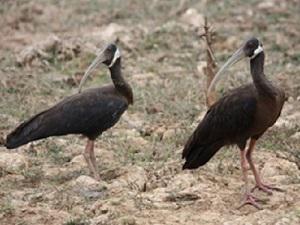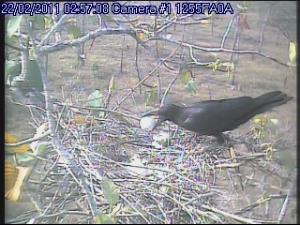Hugh Wright
This study will determine the main nest predators of critically endangered White-shouldered Ibis. The species is experiencing low breeding productivity and understanding the causes of nest failure will inform immediate conservation action.

White-shouldered Ibis at a seasonal pool.
The critically endangered White-shouldered Ibis, Pseudibis davisoni, has been hailed as the most threatened large waterbird in South-East Asia. The species declined dramatically between the 1920s and 1960s, disappearing from the majority of its former range. It is now confined almost entirely to northern and eastern Cambodia. Much of the species’s basic ecology and the reasons for the decline are poorly understood. Since 2008, University of East Anglia, UK, has been conducting research on this species in collaboration with conservation partners in Cambodia.

Jungle crow taking an egg.
White-shouldered Ibis breed during the dry season (December-May), when they take advantage of amphibian and invertebrate prey at seasonal pools, found frequently in the dry dipterocarp forest landscapes. They are solitary breeders, nesting in tall dipterocarp trees and typically laying 3 eggs. The largest known breeding population occurs at Western Siem Pang IBA in Stung Treng province, where 13 nests were located in the 2008-2009 season. A study of nest productivity at this site found that nest success was low, with a 65% failure rate during the incubation and brooding stages.
Predation is the likely cause of these nest failures but the predators responsible are unconfirmed. Possibilities include Common Palm Civet (Paradoxurus hermaphrodites), Yellow-throated Marten (Martes flavigula) and Southern Jungle Crow (Corvus macrorhynchos). This project is using specially-built nest cameras from the Royal Society for the Protection for Birds to photograph predators when they enter the nest. Cameras will be installed at several nests in 2010-2011, while taking necessary precautions to prevent unwanted disturbance to the ibis.
Predator events captured as these nests will provide the first evidence of predator species and their relative importance. This information will inform conservationists of the best techniques for nest protection. For example, if mammalian and/or reptilian predation proves to be significant, these animals can be prevented from reaching nests by attaching plastic sheeting to the trunks of nest trees. Such conservation measures are simple yet are likely to provide the best immediate means of conserving the White-shouldered Ibis.